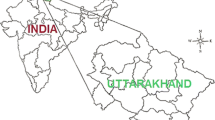Abstract
This study develops three neural networks models for estimating daily pan evaporation (PE) in South Korea: multilayer perceptron-neural networks model (MLP-NNM), generalized regression neural networks model (GRNNM), and adaptive neuro-fuzzy inference system (ANFIS). Daily PE was estimated at Daegu and Ulsan stations using temperature-based, radiation-based, sunshine duration-based and merged input combinations under lag-time patterns. Daily evaporation values computed by the models using merged inputs agreed with observed values. Comparison was also made between the neural networks models and multiple linear regression model (MLRM), which showed the superiority of MLP-NNM, GRNNM, and ANFIS over MLRM. It is concluded that the applied neural networks models can be successfully employed for estimating daily PE in South Korea.










Similar content being viewed by others
References
ASCE Task Committee on Definition of Criteria for Evaluation of Watershed Models (1993) Criteria for evaluation of watershed models. J Irrig Drain Eng 119(3):429–442
Bruton JM, McClendon RW, Hoogenboom G (2000) Estimating daily pan evaporation with artificial neural networks. Trans ASAE 43(2):491–496
Brutsaert WH (1982) Evaporation into the atmosphere. Reidel, Dordrecht
Guven A, Kisi O (2011) Daily pan evaporation modeling using linear genetic programming technique. Irrig Sci 29(2):135–145
Haykin S (2009) Neural networks and learning machines, 3rd edn. Prentice Hall, NJ
Jang JSR (1993) ANFIS: adaptive-network-based fuzzy inference system. IEEE Trans Syst Manag Cybern 23(3):665–685
Jang JSR, Sun CT, Mizutani E (1997) Neurofuzzy and soft computing: A computational approach to learning and machine intelligence. Prentice-Hall, NJ
Keskin ME, Terzi O (2006) Artificial neural networks models of daily pan evaporation. J Hydrol Eng 11(1):65–70
Kim S, Kim HS (2008a) Uncertainty reduction of the flood stage forecasting using neural networks model. J Am Water Res Assoc 44(1):148–165
Kim S, Kim HS (2008b) Neural networks and genetic algorithm approach for nonlinear evaporation and evapotranspiration modeling. J Hydrol 351(3–4):299–317
Kim S, Kim JH, Park KB (2009a) Neural networks models for the flood forecasting and disaster prevention system in the small catchment. Disaster Adv 2(3):51–63
Kim S, Kim JH, Park KB (2009b) Statistical learning theory for the disaggregation of the climatic data. Proc. 33rd IAHR Congress 2009, IAHR, Vancouver, Canada, 1154–1162
Kim S, Shiri J, Kisi O (2012) Pan evaporation modeling using neural computing approach for different climatic zones. Water Resour Manag 26(11):3231–3249
Kisi O (2006) Daily pan evaporation modeling using a neuro-fuzzy computing technique. J Hydrol 329(3–4):636–646
Kisi O (2009) Modeling monthly evaporation using two different neural computing technique. Irrig Sci 27(5):417–430
Kumar M, Raghuwanshi NS, Singh R, Wallender WW, Pruitt WO (2002) Estimating evapotranspiration using artificial neural networks. J Irrig Drain Eng 128(4):224–233
Marino MA, Tracy JC, Taghavi SA (1993) Forecasting of reference evapotranspiration. Agric Water Manag 24(3):163–187
Moghaddamnia A, Ghafari Gousheh M, Piri J, Amin S, Han D (2009) Evaporatin estimation using artificial neural networks and adaptive neurofuzzy inference system techniques. Adv Water Resour 32:88–97
Nash JE, Sutcliffe JV (1970) River flow forecasting through conceptual models, Part 1 – A discussion of principles. J Hydrol 10(3):282–290
NeuroDimension Inc (2005) Developers of NeuroSolutions V5.01: Neural Network Simulator, Gainesville, FL
Rosenberry DO, Winter TC, Buso DC, Likens GE (2007) Comparison of 15 evaporation methods applied to a small mountain lake in the northeastern USA. J Hydrol 340(3–4):149–166
Shiri J, Kisi O (2011) Application of artificial intelligence to estimate daily pan evaporation using available and estimated climatic data in the Khozestan Province (Southwestern Iran). J Irrig Drain Eng 137(7):412–425
Shiri J, Dierickx W, Pour-Ali Baba A, Neamati S, Ghorbani MA (2011) Estimating daily pan evaporation from climatic data of the state of Illinois, USA using adaptive neuro-fuzzy inference system (ANFIS) and artificial neural network (ANN). Hydrol Res 42(6):491–502
Shirsath PB, Singh AK (2010) A comparative study of daily pan evaporation estimation using ANN, regression and climate based models. Water Resour Manag 24:1571–1581
Simpson PK (1990) Artificial neural systems: Foundations, paradigms, applications and implementations. Pergamon, NY
Sudheer KP, Gosain AK, Rangan DM, Saheb SM (2002) Modeling evaporation using an artificial neural network algorithm. Hydrol Process 16:3189–3202
Tabari H, Marofi S, Sabziparvar AA (2009) Estimation of daily pan evaporation using artificial neural network and multivariate non-linear regression. Irrig Sci 28(5):399–406
Tan SBK, Shuy EB, Chua LHC (2007) Modeling hourly and daily open-water evaporation rates in areas with an equatorial climate. Hydrol Process 21(4):486–499
Terzi O, Keskin ME (2005) Evaporation estimation using gene expression programming. J Appl Sci 5(3):508–512
Tsoukalas LH, Uhrig RE (1997) Fuzzy and neural approaches in engineering. Wiley, NY
Vernieuwe H, Georgieva O, De Baets B, Pauwels VRN, Verhoest NEC, De Troch FP (2005) Comparison of data-driven Takagi-Sugeno models of rainfall-discharge dynamics. J Hydro 302(1–4):173–186
Wasserman PD (1993) Advanced methods in neural computing. Van Nostrand Reinhold, NY
Acknowledgements
The first author, Sungwon Kim, would like to acknowledge the financial support from Dongyang University for the sabbatical levee at Texas A & M University during the course of this study.
Author information
Authors and Affiliations
Corresponding author
Rights and permissions
About this article
Cite this article
Kim, S., Shiri, J., Kisi, O. et al. Estimating Daily Pan Evaporation Using Different Data-Driven Methods and Lag-Time Patterns. Water Resour Manage 27, 2267–2286 (2013). https://doi.org/10.1007/s11269-013-0287-2
Received:
Accepted:
Published:
Issue Date:
DOI: https://doi.org/10.1007/s11269-013-0287-2




